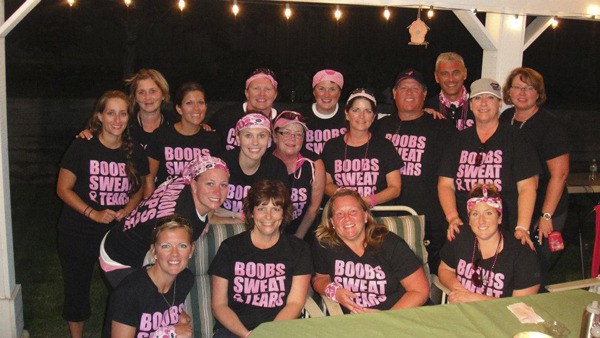In 2006, Mary Charron thought she had beaten breast cancer.
Charron had been diagnosed with Stage IIB Invasive Ductile the previous December, and she did everything one does after receiving that kind of news: She had surgery to remove two tumors and 10 auxiliary lymph nodes from her left breast; sixteen weeks of chemotherapy and its side effects; and more than six weeks of radiation therapy.
At the end of treatment, her mammogram came back clear, and she and her family believed life would return to normal.
“Sometimes in your life, something happens that is so monumental, so all encompassing, that your are forever changed,” Charron wrote in a letter to friends. “Sometimes it is for the good and sometimes it is not. Sometimes it strengthens your faith and other times, it challenges the very foundation of your being. Sometimes it does all of the above.”
By fall 2008, Charron felt whispers of pain in her back. She initially wrote it off as a sign she was out of shape.
A few weeks later, the whispers became screams. An audible pop in her back heralded a bout of “excruciating” pain that only became worse over time. Physical therapy did nothing to help.
One day, Charron got up from her seat and promptly collapsed.
“I was ice cold,” she wrote. “And I began to shake uncontrollably.”
One day and a battery of tests later, Charron learned her cancer had returned and metastasized in her bones: vertebrae, ribs, sternum, skull, left femur, right hip, and her pelvis. Treatable, but not curable.
The thing about cancer is, it’s a violent nomadic force. And, like its brother aggressors in history, it doesn’t spare much thought for the territory it invades. It wages total war.
The enemy was at the gates and Charron’s bones were disintegrating. Surgeons would have to act fast to save them.
Charron underwent five surgeries in 15 days: four to gird or replace her weakened bones, and one to install a port catheter for chemotherapy.
After more than a month in the hospital, Charron returned home December 2008 in a weakened state and encumbered by torso and neck braces. The devices ensured she didn’t twist her still-delicate spine, but rendered her largely helpless without assistance in everyday tasks.
By February 2009, the braces had come off and she could begin physical therapy to rebuild her support muscles.
By the Fourth of July, after months of support from friends and neighbors accompanying her on walks, she could walk half a mile with a cane. And by Spring 2010, she ditched the cane. Despite aches and pains, Charron was able to return to some semblance of normalcy: volunteering for Girl Scouts, helping out at her daughters’ school, and cheering them on at sports and marching band.
During this period of recovery, neighbors in the Brookfield community formed a Susan G. Komen 3-Day walking team. Participants walk 60 miles over three days to raise money for Susan G. Komen For The Cure, an organization that funds and advocates breast cancer research. The four members of “Charron Steps For A Cure” raised $12,522 in 2009.
“I told Mary that I wasn’t going to stop doing this,” team captain Deneen Nelson said.
The team has since grown, and funds rose to $12,870 in 2010, $28,000 in 2011, and approximately $35,000 in 2012.
Unfortunately, Charron was becoming more easily fatigued midway into 2010. Her red and white blood cell counts dropped and her CA-153 test results—a cancer marker—rose. A bone scan revealed that while Charron’s existing lesions weren’t growing, new ones had appeared.
One of the lesions responded to three weeks of radiation therapy, but in three months another grew in size and additional lesions had appeared. Charron’s oncologist recommended a third round of chemo, and she was approved for an experimental PARP inhibitor drug designed to prevent cancer cells from self-repairing.
The treatment was a failure.
“My cancer continued to progress under this regimen and I was pulled from the study in January 2011,” Charron wrote. “This was probably for the best as I was not tolerating the chemo very well. My hands were numb and I felt absolutely horrible. Mentally, I was sliding quickly into depression and just could not function in normal day to day activities.”
A one month break followed and Charron returned to Abraxane, her first chemo drug. The cancer continued to spread and she was taken off chemo and put on a regimen of Arimidex and Faslodex. After two months, it was discovered her thyroid had stopped functioning and she was put on a daily medication that improved her energy levels.
The roller coaster continued: Charron’s cancer markers more than tripled from April to July 2011. Cycles of Xeloda, an oral chemotherapy drug, eventually brought her markers below April levels; with exhausting side effects.
“For now we keep fighting and I am enjoying all the little things in life I used to take for granted,” Charron wrote. “I continue to pray for an absolute cure for this disease and not just a temporary fix. There are so many people working so hard for this cause that I have to believe we will be successful.”
In the meantime, friend Nelson has continued her promise to continue with the Komen 3-Day team.
“I’ve asked for 25 team members for 2013, and we’ve set a $55,000 goal,” she said.
More information on the “Charron Steps For A Cure” team can be found at their Facebook page, www.facebook.com/pages/Charron-Steps-For-A-Cure/168042726579041.



